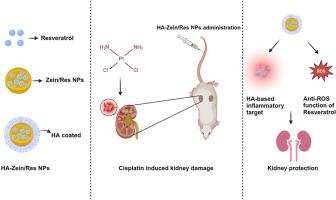透明质酸包裹的泽因纳米粒子介导的白藜芦醇疗法可减少顺铂相关的肾毒性。
IF 2.5
3区 生物学
Q3 BIOCHEMISTRY & MOLECULAR BIOLOGY
Biochemical and biophysical research communications
Pub Date : 2024-10-22
DOI:10.1016/j.bbrc.2024.150873
引用次数: 0
摘要
顺铂(CDDP)是临床上常用的抗癌药物,但严重的肾毒性使其无法发挥抗癌作用。白藜芦醇等天然药物可以减轻顺铂的副作用,但其溶解度低和胃肠道效应使其无法发挥作用。在此,我们开发了以生物相容性材料玉米蛋白为载体的治疗肾损伤的纳米粒子。HA-Zein/Res NPs 采用低分子量透明质酸涂层制成。这种制剂对肾小管上皮细胞无细胞毒性,可以放心使用。低分子量透明质酸具有炎症靶向特性,而 CDDP 损伤会导致肾脏炎症。由于低分子量透明质酸涂层的这一特性,在小鼠体内进行的成像实验表明,HA-Zein/Res NPs 使更多的纳米粒子聚集在受炎症影响的肾脏部位。实验证明,HA-Zein/Res NPs 在降低小鼠血清肌酐和尿素氮水平的同时,还能治疗肾损伤。总之,这些结果表明,这种纳米材料是一种很有希望降低顺铂临床肾毒性的药物。本文章由计算机程序翻译,如有差异,请以英文原文为准。

Hyaluronic acid-coated zein nanoparticle-mediated resveratrol therapy for the reduction of cisplatin-associated nephrotoxicity
Cisplatin (CDDP) is commonly used as an anticancer drug in clinical practice, but severe nephrotoxicity restricts it from exerting anticancer effects. Natural drugs, such as resveratrol, can alleviate the side effects of cisplatin, but their low solubility and gastrointestinal effects prevent them from working. Herein, we developed nanoparticles for kidney injury consisting of a biocompatible material, zein, as a carrier. HA-Zein/Res NPs were fabricated using low-molecular-weight hyaluronic acid coatings. This preparation is non-cytotoxic to renal tubular epithelial cells and can be used with confidence. Low-molecular-weight hyaluronic acid has inflammation-targeting properties and CDDP damage causes renal inflammation. Owing to this property of the low-molecular-weight hyaluronic acid coating, in vivo imaging experiments in mice demonstrated that the HA-Zein/Res NPs enabled more nanoparticles to accumulate in the renal sites affected by inflammation. Efficient resveratrol delivery alleviated kidney injury, and experiments demonstrated that HA-Zein/Res NPs could treat kidney injury while reducing the serum creatinine and urea nitrogen levels in mice. Collectively, these results indicated that this nanomaterial is a promising agent for reducing the clinical nephrotoxicity of cisplatin.
求助全文
通过发布文献求助,成功后即可免费获取论文全文。
去求助
来源期刊
CiteScore
6.10
自引率
0.00%
发文量
1400
审稿时长
14 days
期刊介绍:
Biochemical and Biophysical Research Communications is the premier international journal devoted to the very rapid dissemination of timely and significant experimental results in diverse fields of biological research. The development of the "Breakthroughs and Views" section brings the minireview format to the journal, and issues often contain collections of special interest manuscripts. BBRC is published weekly (52 issues/year).Research Areas now include: Biochemistry; biophysics; cell biology; developmental biology; immunology
; molecular biology; neurobiology; plant biology and proteomics

 求助内容:
求助内容: 应助结果提醒方式:
应助结果提醒方式:


